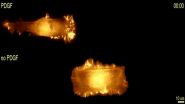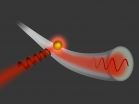(Press-News.org) By studying identical twins, researchers from Lund University in Sweden have identified mechanisms that could be behind the development of type 2 diabetes. This may explain cases where one identical twin develops type 2 diabetes while the other remains healthy.
The study involved 14 pairs of identical twins in Sweden and Denmark. One twin had type 2 diabetes and the other was healthy.
"Twins are a good model for finding mechanisms, but the results are applicable to all", said Emma Nilsson, who carried out the study with Charlotte Ling.
We know that fat tissue can release hormones and regulate metabolism in different organs in the body. The question the researchers posed was whether epigenetic* changes in the DNA lead to changes in the fat tissue that in turn can lead to the development of type 2 diabetes.
The researchers investigated DNA methylation* at 480 000 points on the DNA and looked at how it affected the expression of the genes in the identical twins. They found that genes that are involved in inflammation were up-regulated and that genes involved in the fat and glucose metabolism were down-regulated in those who had diabetes.
"This means that they are not able to process fat as well, which leads to raised levels of fat in the blood and uptake of fat by other organs instead, such as the muscles, liver or pancreas. This causes insulin resistance, which leads to type 2 diabetes", said Emma Nilsson.
They found that the sets of twins had very similar DNA methylation, which according to Emma Nilsson suggests strong heredity.
The researchers went on to compare non-identical twins with identical twins and found that the similarities were greater in identical twins.
"Non-identical twins generally share 50 per cent of their DNA and it is usually said that identical twins share 100 per cent of theirs. Despite this, we found 1 400 places on the identical twins' DNA where there was a difference in DNA methylation between the diabetic and the non-diabetic. It is believed that these differences are due to differences in lifestyle and this confirms the theory that type 2 diabetes is strongly linked to lifestyle."
A further discovery in the DNA was that there were certain changes in the actual DNA sequence – the genetic code – that differed between the diabetic and non-diabetic twin. This was a new finding.
Put in simple terms, small parts of the genetic code can be duplicated or be absent. Having too many or too few copies of a certain DNA sequence leads to changes in the properties of the specific gene.
"We found six cases where one of the set of twins had more or fewer of these copies in his or her DNA, and we suspect that this could be another cause of the disease", said Emma Nilsson, continuing:
"This is interesting because it is usually taken for granted that identical twins are genetically 100 per cent alike. However, there are in fact differences and it is not known whether, or how, these affect the development of type 2 diabetes. More studies are needed to investigate their impact."
INFORMATION:
http://diabetes.diabetesjournals.org/content/63/9/2962.full END
Worldwide there have been 71 documented cases of patients with anaplastic large cell lymphoma (ALCL) in which researchers suspected breast implants to be the cause. ALCL is normally found in the lymph nodes, as well as in skin, lung, liver and soft tissue, but not usually in the breast. Cases in which ALCL developed in the breast region almost exclusively involved patients who have had breast surgery. In these cases, ALCL developed around ten years after the operation. The tumours grew in the scar tissue around the implant.
Breast implants are generally safe and studies ...
New theoretical physics models could help us better grasp the atmospheric chemistry of ozone depletion. Indeed, understanding photoabsorption of nitrous oxide (N2O) — a process which involves the transfer of the energy of a photon to the molecule — matters because a small fraction of N2O reacts with oxygen atoms in the stratosphere to produce among others nitric oxide (NO). The latter participates in the catalytic destruction of ozone (O3). Now, new theoretical work unveils the actual dynamic of the photoabsorption of nitrous oxide molecules. These findings by Mohammad ...
VIDEO:
The cell stimulated with the growth factor PDGF (upper cell) migrates targeted in only one direction on its track, while the not stimulated cell (lower cell) changes its direction of...
Click here for more information.
During cancer metastasis, immune response or the development of organisms, cells are moving in a controlled manner through the body. Researchers from the Department of Biomedicine at the University of Basel discovered novel mechanisms of cell migration by ...
Viruses can convert their DNA from solid to fluid form, which explains how viruses manage to eject DNA into the cells of their victims. This has been shown in two new studies carried out by Lund University in Sweden.
Both research studies are about the same discovery made for two different viruses, namely that viruses can convert their DNA to liquid form at the moment of infection. Thanks to this conversion, the virus can more easily transfer its DNA into the cells of its victim, which thus become infected. One of the studies investigated the herpes virus, which infects ...
This news release is available in German.
How can a beam of light tell the difference between left and right? At the Vienna University of Technology (TU Wien) tiny particles have been coupled to a glass fibre. The particles emit light into the fibre in such a way that it does not travel in both directions, as one would expect. Instead, the light can be directed either to the left or to the right. This has become possible by employing a remarkable physical effect – the spin-orbit coupling of light. This new kind of optical switch has the potential to revolutionize ...
They emerge at night, while we sleep unaware, growing and spreading out as quickly as they can. And they are deadly. In a surprise finding that was recently published in Nature Communications, Weizmann Institute of Science researchers showed that nighttime is the right time for cancer to grow and spread in the body. Their findings suggest that administering certain treatments in time with the body's day-night cycle could boost their efficiency.
This finding arose out of an investigation into the relationships between different receptors in the cell – a complex network ...
Over the years, researchers have described how some of the body's cells have giant channels – a kind of holes that completely uncritically allow both small and large molecules to penetrate into and out of the cell. The hypothesis is that these normally closed gatekeeper proteins in the cell membrane allow unrestricted access in the event of diseases such as myocardial infarction, stroke or Alzheimer's. If the hypothesis was correct, the obvious choice would be to look for novel drugs to block the relevant membrane proteins and in this way cure or prevent disease.
New ...
A specialist group of European researchers are studying the remains of prehistoric human settlements which are now submerged beneath our coastal seas. Some of these drowned sites are tens of thousands of years old. From the progressive discovery and analysis of these prehistoric remains, a new scientific field has emerged, combining the expertise from many disciplines including archaeology, oceanography and the geosciences. The new field is called Continental Shelf Prehistoric Research.
This rapidly evolving research field is the focus of a new European Marine Board ...
Since the first human fetal surgery was reported in 1965, several different fetal surgical procedures have been developed and perfected, resulting in significantly improved outcomes for many fetuses. However, the significant investments associated with this highly specialized service and quality metrics must be considered as more fetal treatment programs are developed.
Katharine D. Wenstrom, MD, director of the Division of Maternal-Fetal Medicine at Women & Infants Hospital of Rhode Island, co-director of the hospital's Integrated Program for High-Risk Pregnancy, and ...
WASHINGTON, Oct. 6, 2014 — It's happened to many of us: Half asleep in the morning, you finish brushing your teeth and reach for your daily glass of orange juice. After taking a big swig, you spit it back out, making a face like you've just chewed on a lemon. Turns out, a specific chemical in your toothpaste is responsible for that nasty taste. This week, Reactions explains why toothpaste and orange juice don't mix. Learn all about it at https://www.youtube.com/watch?v=9X5_gtel-c0.
Subscribe to the series at Reactions YouTube, and follow us on Twitter @ACSreactions to ...



